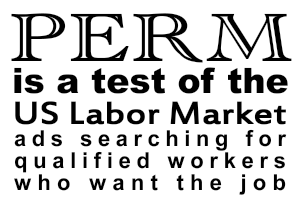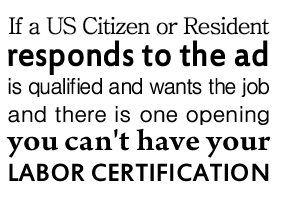
PERM Labor Certification
The Department of Labor’s certification authority is based on 8 USC § 1182(a)(5)(A), which provides that a foreign national cannot be granted permanent status in the United States unless the Department certifies that:
- There are not sufficient United States workers who are able willing, qualified, and available at the time of the application for a visa and admission into the United States at the place where the alien is to perform the work; and
- The employment of the alien will not adversely affect the wages and working conditions of similarly employed United States workers
 Initially, the Department required supervised recruitment for all labor certification cases. Supervised recruitment required the State Workforce Agency to direct the employer’s recruitment for qualified, available US workers and to designate an address at a SWA office for interested job seekers to send resumes. A SWA processing specialist would then evaluate resumes, if any, and forward them to the employer for review and action.
Initially, the Department required supervised recruitment for all labor certification cases. Supervised recruitment required the State Workforce Agency to direct the employer’s recruitment for qualified, available US workers and to designate an address at a SWA office for interested job seekers to send resumes. A SWA processing specialist would then evaluate resumes, if any, and forward them to the employer for review and action.
This process proved expensive for the states and the Department. The Department of Labor does not charge a filing fee for the labor certification process and funds certification operations with general budget funds. And the Department provided cash grants to SWAs to pay the costs of administering the process. Gradually, years-long backlogs developed from a lack of funding and even the funding provided was viewed as a significant drain on the Department’s resources.
In 1998 the Department devised an attestation-based recruitment process it named Reduction-in-Recruitment, which allowed employers to conduct pre-filing recruitment and then to submit proof of the recruitment and the results of the recruitment to the Department for processing. If the employer met certain requirements, the case would be processed without further recruitment required. If the employer failed, the Certifying Officer referred the case for supervised recruitment.
Eventually even RIR operations became too expensive and resulted in backlogs that exceeded two years. In May 2002 the Department published proposed regulations to streamline the entire process so that most filings would be made electronically, employers would always conduct pre-filing recruitment, and the employer would forward no supporting documents to the Department, but would instead sign an attestation under penalty of perjury and be subject to random audit to confirm the facts attested to in the application. After several years of planning, the Department finally unveiled the new functioning system on March 28, 2005: Program Electronic Review Management, or PERM.
evaluation and planning before placing ads
Good planning involves working through the entire process before placing an advertisement, seeking a prevailing wage or filing a PERM case. Good  planners will evaluate all company and employee information and prepare a draft PERM application I-140 and I-485 – in effect preparing all necessary forms and applications for the entire process through to obtaining the green card.
planners will evaluate all company and employee information and prepare a draft PERM application I-140 and I-485 – in effect preparing all necessary forms and applications for the entire process through to obtaining the green card.
Why do this much work in advance? The answer is that problems can arise at various stages in this process. By failing to evaluate all potential problems, an attorney may force the employer into a situation that is difficult or impossible to resolve at a later stage in the process. Similarly, obstacles to qualification in one of the employment-based preference categories, or adjustment of status may result in an employee being ineligible for a green card through employment. Good planning means adequately evaluating the entire case from start to finish before filing a single document with the government.
where and how many ads to place
Recruitment requirements are divided into nonprofessional and professional occupations and the Department requires additional recruitment steps for professional occupations. For professional occupations, the Department requires these two recruitment steps found at 20 CFR § 656.17(e)(1):
- A job order with the state workforce agency for a period of 30 days;
- Two Sunday newspaper ads in the newspaper of general circulation in the area of intended employment "most appropriate to the occupation and the workers likely to apply for the job opportunity and most likely to bring responses from able, willing, qualified, and available U.S. workers;"
The employer must also select three additional recruitment steps from the alternatives listed at 20 CFR § 656.17(e)(1)(ii)(A)-(J):
A. Job Fairs
B. Employer's Website
C. Job search Website other than the employer's
D. On-campus recruiting
E. Trade or professional organizations
F. Private employment firms
G. Employee referral program with incentives
H. Campus placement offices
I. Local and ethnic newspapers
J. Radio and television advertisements
For non-professional occupations, the only recruitment required is a 30-day job order with the State Workforce Agency and two Sunday newspaper ads. The employer's minimum qualifications alone don't determine whether the job is professional or non-professional. Instead, DOL published a list in the Federal Register called Appendix A that lists professional jobs. Even if the employer's minmum qualifications do not include a bachelor's degree, if the job is listed on Appendix A, it requires professional-style recruitment steps.
what needs to be in an advertisement
The regulations at 20 C.F.R. §656.17(f) provide that each advertisement an employer places must meet the following requirements:
- Name the employer;
- Direct applicants to report or send resumes, as appropriate for the occupation, to the employer;
- Provide a description of the vacancy specific enough to apprise U.S. workers of the job opportunity for which certification is sought;
- Indicate the geographic area of employment with enough specificity to apprise applicants of any travel requirements and where applicants will likely have to reside to perform the job opportunity;
- Not contain a wage rate lower than the prevailing wage rate;
- Not contain any job requirements or duties which exceed the job requirements or duties listed on the ETA Form 9089; and
- Not contain wages or terms and conditions of employment that are less
- favorable than those offered to the alien.
In comments to the PERM regulations, the Department indicated that for newspaper ads, a lesser standard "might" be acceptable, but reliance on this language has proven problematic (69 Fed. Reg. 77347, December 27, 2004):
An advertisement that includes a descriptive job title, the name of the employer, and the means to contact the employer might be sufficient to apprise potentially qualified applicants of the job opportunity.
the position’s location
Advertising and prevailing wage data must be prepared with regard to the “area of intended employment” – this means the area within normal commuting distance of the place of intended employment. Places within MSAs or PMSAs are deemed normal commuting distance, areas within CMSA will not automatically be deemed to be within normal commuting distances. The borders of PMSAs, MSAs, or CMSAs are not controlling in the identification of the normal commuting area and therefore an employer location just outside of such a boundary may still be considered within normal commuting distance. Advertising in the wrong newspaper or changing worksite addresses before the green card is finally issued by DHS may result in the application failing and the employer having to begin anew. For this reason it is important to estimate the duration of the process for each employee and then to also estimate whether that employee’s job will likely move while the application is pending.
wages and salaries
The Department passed regulations providing for a new system of four levels of wages two replace the old system of two levels. This has resulted in relief for many employers seeking to certify mid-level positions because the previous two-tier system provided unrealistically high prevailing wages for most employees falling in between new hires and those with senior experience. However, under the new regulations, employers must pay 100% of the determined prevailing wage for all labor certification and H-1B cases filed after December 8, 2004. The old rule allowed employers to pay 95% of the prevailing wage.
Employers may challenge wage determinations within thirty days by filing a request in writing to SWA that made the determination and the request must identify the specific wage request, the grounds for the request and include all materials submitted to the SWA up to the date the determination was made. The SWA will then forward the request to the national processing center and then to a Department of Labor Certifying Officer (CO) who may affirm, modify, or remand the wage to the SWA for further action. Employers may also appeal the CO’s decision to BALCA within 30 days of the CO determination by making a request in writing to the CO.
how the department calculates the prevailing wage
While Department of Labor now processes prevailing wage requests directly, the guidelines DOL gave to State Workforce Agencies to process prevailing wage requests is useful in anticipating the wage Department of Labor will calculate based on the fact you provide.
First the wage specialist looks at O*NET to find the occupation listed there that most closely matches the description provided by the employer. Then the specialist reviews the O*NET Job Zones and chooses the experience “zone” that most closely matches the minimum requirements provided by the employer.
Then, for occupations listed in Job Zone 1, if the employer’s experience requirement is equivalent to that described in an:
- SVP of 1 (experience requirement of a short demonstration), enter a 0 in the Wage Level Column
- SVP of 2 (experience requirement of anything beyond short demonstration and up to 1 month), enter a 1 in the Wage Level Column
- SVP of 3 (experience requirement of over 1 month and up to and including 3 months), enter a 2 in the Wage Level Column
- SVP of 4 (experience requirement of over 3 months up to and including 6 months), enter a 3 in the Wage Level Column
For occupations in Job Zones 2 through 4, if the employer’s experience requirement is:
- In the low end of the experience and SVP range, enter a 1 in the Wage Level Column
- In the high end of the experience and SVP range, enter a 2 in the Wage Level Column
- Greater than the experience and SVP range, enter a 3 in the Wage Level Column
Then, the specialist looks to see if the employer’s minimum education requirements exceed those generally required for the position as provided by O*NET. If the minimum education the employer requires on the wage request form is more than the usual contained in Appendix D, enter a 1 in the Wage Level Column (for example if the employer requires a Master’s and O*NET suggests a master’s degree is appropriate). If the minimum education the employer requires on the wage request form is more than the usual contained in Appendix D by more than one category, enter a 2 in the Wage Level Column (for example if the employer requires a Ph.D. and O*NET suggests a bachelor’s degree is appropriate)
Finally, the specialist will enter a 1 one on the worksheet in the Wage Level Column if the employer lists tasks, work activities, knowledge or skills not listed in the O*NET sections. Additionally, where a license is required to be employed in a certain field by national or state licensing laws, licensed workers will be considered to be performing work at a Level 2.
The specialist determines which wage level applies based on how many points over the baseline level the subject job's requirements are. Level I wages are generally those that require no special knowledge or experience above the education and experience qualifications listed as normal in O*NET's description of the job.
minimum education and experience requirements
O*NET now controls and uses “job zones” instead of SVP. For many jobs, this isn’t a big change, but for many computer consulting and engineering positions, it appears that requiring a bachelor’s plus five years of experience or a master’s degree will exceed the Department of Labor’s imputed industry standard for these positions, while it did not using the previous SVP standards.
Jobs that require a minimum of two years of experience and up to less than a Master's degree or a bachelor's degree and less than five years of experience fall into the third preference category. Jobs that require a minimum of a bachelor's degree and five years of experience, or a master's degree fall into the second preference category.
At the time of filing the beneficiary need not be employed in the job that is the subject of the labor certification, nor even be employed by the same company filing the labor certification application. But the beneficiary must meet the job's minimum qualifications before the employer files the labor certification application. Matter of Wing’s Tea House, 16 I&N Dec. 158 (R.C. 1977), and Matter of Katigbak, 14 I.&N. Dec. 45 (R.C. (1971). There is no exception to this rule.
Education and experience rules for labor certification are very different than the ones for H-1B status. Generally labor certification does not allow experience "equivalants" to a degree, but the H-1B program does. For a detailed discussion of education and experience rules in the labor certification and H-1B program, see our discussion here.
It is wise for the HR professional to review the O*NET job description and minimum requirements for the position when crafting a position’s duties. O*NET can be consulted on the Internet at http://online.onetcenter.org/. For HR professionals familiar with the Dictionary of Occupational Titles (DOT), the O*NET website offers a DOT to O*NET crosswalk.
Because India, China, and the Philippines now have three year backlogs for third preference category petitions, the second preference category is a highly sought after status for many information technology professionals.
experience gained on-the-job
Under the old rules, it was difficult to argue that experience should count in the application where the foreign worker gained the experience on-the-job at the applicant employer. Under the new regulations it is still difficult, but with the improvement that the new regulations provide a clear standard: to use experience gained on-the-job, the employer must demonstrate that the job in which the foreign worker gained the experience is not “substantially comparable” to the job the employer seeks certification for. The regulations state that the two jobs are substantially comparable if they share more than fifty percent of the job duties as measured by time spent working.
Again, although under certain circumstances a beneficiary may use experience gained on-the-job, the beneficiary must meet the job's minimum qualifications before the employer files the labor certification application. Matter of Wing’s Tea House, 16 I&N Dec. 158 (R.C. 1977), and Matter of Katigbak, 14 I.&N. Dec. 45 (R.C. (1971). There is no exception to this rule.
evaluating whether US workers qualify
A U.S. worker is a U.S. citizen or permanent resident. The employer must offer the position to any U.S. worker who qualifies for it. If the employer has fewer openings than qualified workers who accept the offer of employment, the Certifying Officer may not certify the application.
An employer may disqualify U.S. workers who do not meet the education, training, or experience requirements, but employers that list many easy to acquire skills as a prerequisite to employment will face problems.
The Department of Labor deems a U.S. worker able and qualified for the job opportunity if the worker can acquire the skills necessary to perform the duties involved in the occupation during a reasonable period of on-the-job training. Rejecting U.S. workers for lacking skills necessary to perform the duties involved in the occupation, where the U.S. workers are capable of acquiring the skills during a reasonable period of on-the-job training is not a lawful job-related reason for rejection of the U.S. workers. 20 C.F.R. § 656.17(g)(2).
may an employer file multiple labor certification applications for the same worker?
Generally, an employer may file one labor certification application for a single job opportunity for the same employee. To file another labor certification application, the employer must first withdraw the earlier one.
There is no restriction on filing more than one labor certification for the same employee if the applications are for different job opportunities - for example the same job, but in a different county or state. And if an employee is being promoted from one job to another and the new job has less than 50% of the job duties in common with the earlier position, the company may file a new labor certification for the new job for the same employee and use the priority date from the earlier approved labor certification and I-140 petition.
schedules A and B
Schedule A is a list of positions that do not require a labor certification because the Department of Labor has found that there is a shortage of qualified US workers and the employer therefore need not test the labor market to prove that shortage. The notable change to Schedule A is that performing artists of exceptional ability have been added to the list. Performing arts had some difficulty qualifying as artists under the old regulations and this should significantly ease the difficulty of filing Schedule A cases for performing artists.
Schedule B was a list under the old regulations of positions that did not qualify for labor certification because the Department of Labor found that there were generally enough qualified US workers available for such jobs. The list included some service industry positions and “blue collar” occupations.” But even if a position was listed on Schedule B, a waiver was available because, as the Department noted in the preamble to the new regulations, it was not possible for the Department to know for certain that there were no qualified US workers available for all Schedule B positions in every town in the United States. Because the waiver process under the old regulations entailed a test of the job market virtually identical to the normal labor certification process, Schedule B constituted little more than advice to employers that they ought to be able to find a qualified US worker for positions on the list. The new PERM regulations eliminate schedule B.
notice requirements
In addition to the customary posting notice required under the old regulations, employers must now publish information regarding the job for which certification is sought in “all in-house media in accordance with the normal procedures used for the recruitment of other similar positions.” So in addition to the ten-day posting notice required under the old regulations, employers must be cautious under the new regulations to post notice where it would normally be posted in the course of recruiting for the same or a similar position. And despite comments to the proposed regulations opposing the continued requirement to post notice for Schedule A jobs which are not subject to the labor certification requirement, the Department has retained this requirement and employers must post notice for Schedule A positions such as nurses.
The posting notice must be conspicuously displayed at the worksite location for ten consecutive business days. And notice must be made between 30 and 180 days before the case is filed.
pre-filing advertising requirements
Professional occupations are those for which a bachelor’s or higher degree is the usual requirement for entry into the occupation. Nonprofessional occupations are those which do not customarily require a bachelor’s or higher degree for entry into the occupation. The rules for recruitment for professional occupations are found at 20 CFR §656.17(e)(1) and for nonprofessional occupations at 20 CFR §656.17(e)(2).
professional vs. nonprofessional positions
A professional position is one that requires at least a bachelor's degree. A non-professional position is a position that does not. A skilled worker position is one that requires at least two years of education, training, or experience. Both professionals and skilled workers make applications in the third preference category. For a discussion of of education, training and experience, visit our education page here.
For professional positions the employer must place a 30-day job order with the appropriate SWA and two print advertisements both in Sunday editions of an appropriate general circulation newspaper, plus three additional steps from among those listed in the regulations: (1) employee referral bonus program, (2) online job listing, (3) listing in a professional or trade publication, (4) notice of the job opening at a campus placement office for positions requiring a degree, but no experience, (5) local and ethnic newspapers, to the extent appropriate, (6) radio and television advertisements. The new regulations provide that a maximum of one of these steps may be taken within 30 days of filing.
For nonprofessional positions, the employer must place only the 30-day job order with the appropriate SWA and two newspaper advertisements both in Sunday editions of an appropriate general circulation newspaper.
audits, denials and appeals
PERM relies for integrity upon two types of audits: (1) those generated by the answers to various questions on form ETA 9089 as determined by a changing and secret Department algorithm, and (2) random audits. It is unclear at this early stage how long audited cases will be delayed. The delay will likely depend on the number of cases audited and the results of audits – that is to say that the Department will likely audit fewer cases if it finds from its initial audits that very few applications have been improperly prepared.
In the event a case is denied, employers have a right to request the CO’s reconsideration, refile a case, or to seek administrative review from the Board of Labor Certification Appeals (BALCA). Because the administrative review process imposes significant delays, for most employers it will be wise to simply refile.
revocation
The 2005 PERM regulations give the Certifying Officer the right to revoke a labor certification application at any time where the certification was not justified. Unfortunately, there is no time limit imposed on the Certifying Officer’s revocation power.
duty to retain records for five years
Employers must retain all supporting documents for the labor certification for five years from the date the application is filed with the Department. Employers are subject to random audit and the CO’s authority to revoke a labor certification extends indefinitely. Failure to adequately prepare and retain evidence substantiating the attestations the employer swore in the application, could ultimately lead to civil and criminal penalties.
nurses
Schedule A certification under the new rules requires a CGFNS Certificate rather than merely passage of the CGFNS practical nursing exam. However, documentation that the nurse has passed the NCLEX-RN exam, or holds a full and unrestricted permanent license to practice nursing in the state of intended employment remains sufficient in the alternative as under the old regulations.
The effect of this change is to require employers to wait longer in a nurse’s credentialing process to be able to begin processing the immigration case. It is often the case that foreign nurses have more difficulty with English language testing than they do with the practical nursing exam, and so for many employers this change in the regulations may set back the filing date by six months or longer. Previously, employers could file an the I?140 petition with the old forms seeking the Schedule A exemption where the nurse had merely passed the practical nursing exam and this would allow months to resolve the English language testing and ultimate issuance of the CGFNS Visa Screen Certificate. Especially in light of the current three-year backlog for third preference category cases from India, China and the Philippines, this new rule will add to the wait for many nurses.
filing I-140 and later applications with USCIS
Under the old regulations, the Department of Labor issued a certified original notice of labor certification displaying a special multi-colored stamp on the original signed forms submitted to the Department by the applicant employer. Under the new regulations filing is accomplished electronically, but then DOL sends the employer an approved labor certification application and the employer, employee and attorney must sign this document before submitting it to USCIS with an I-140 petition. The PERM regulations became effective March 28, 2005, but a later regulation effective July 16, 2007 also added an expiration date to approved labor certification applications. Before the new regulations, they did not expire and they were transferable to other employees. This allowed an illicit trade in labor certification applications where employees sometimes paid employers tens of thousands of dollars to use another employee's approved labor certification with a current priority date. Since 2007 labor certification applications have a 180 day validity period - if you don't file the I-140 before the labor certification approval notice expires, you have to start all over again. Labor certifications are also no longer transferrable.
PERM and layoffs
If the employer has had a layoff in the area of intended employment within six months of filing the application that involves the same job, or a related job, then the employer has to document that it has notified and considered all potentially qualified laid off US workers for the job opportunity and document the results of the notification and consideration. 20 CFR §656.17(k). The regulation reads:
If there has been a layoff by the employer applicant in the area of intended employment within 6 months of filing an application [for the same or a similar job], the employer must document it has notified and considered all potentially qualified laid off U.S. workers of the job opportunity...
The employer is not required the disclose layoffs that occurred before the six month period preceding filing the PERM application.
determining layoff dates
Where layoffs are staggered or have flexible end dates, or employees receive compensation on payroll for a period after their last day of work, it may be difficult to determine a layoff date for the purpose of calculating the 180 days. The six month time period has its origin in the Reduction in Recruitment labor certification filing process. Under the RIR program, Department of Labor instructed Certifying Officer to consider available US workers.
notifying previously laid Off US workers of a job opportunity
Who to Notify: The employer only must notify US workers. A US worker is one who is a US citizen, U.S. national, lawful permanent resident (or certain temporary resident), refugee, or asylee. 20 CFR §656.3.The employer only needs to notify laid off US workers who worked in the same, or a related occupation. A related occupation is any occupation that requires workers to perform a majority of the essential duties involved in the occupation for which certification is sought. 656.17(k)(2).
How to Notify: There is no specific method identified in the law for notifying laid off employees of the new job opportunity. Under old case law predating the PERM regulations, courts held that the employer must make a “reasonable effort” to contact the applicant and that the facts differed by case. The American Immigration Lawyers Association sent proposed methods of contact to the Department of Labor to ask if the Department would accept them. These included:
- Sending an e-mail to laid off U.S. workers;
- Mailing a letter or certified mail letter to laid off U.S. workers; and
- Including blanket language in termination letters advising laid off employees to check the company’s website for available job openings, and then posting the job opportunity on the labor certification on the employer's website
As of the date of this letter, Department of Labor has not yet responded to AILA’s inquiry. Sending a certified letter with return receipt requested is probably the safest method of contact from the perspective of trying to document the employer’s efforts to contact laid off US workers.
- Log in to post comments
visit us at:
San José, CA 95008
Santa Cruz, CA 95060
The Olender Pro Bono Project
We represent some clients who have compelling cases and little money at no charge. Sean received the Benito Juarez human rights award in 2008 and the ALRP Volunteer Award in 2012 for taking more than 10 pro bono cases in 12 months. We need volunteers. E-mail Debbie to volunteer.
Change Your Address at DHS!
If you are not a US citizen, you must change your address with DHS within 10 days of moving or face deportation. Click Here.






































